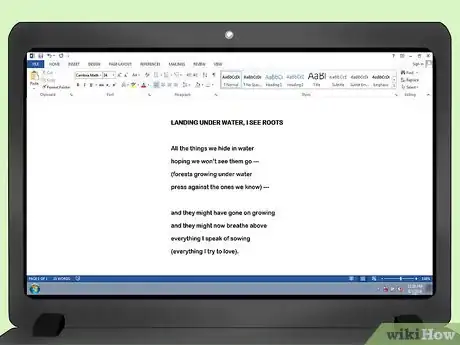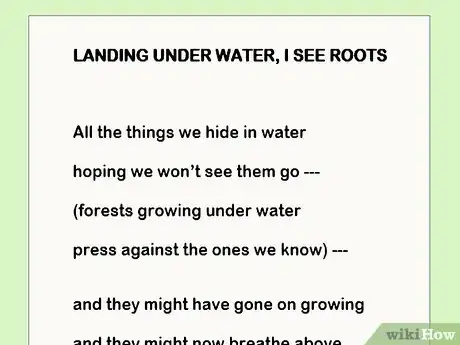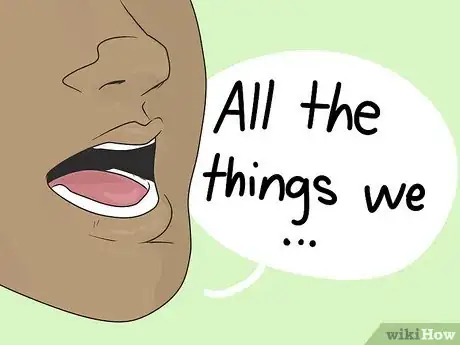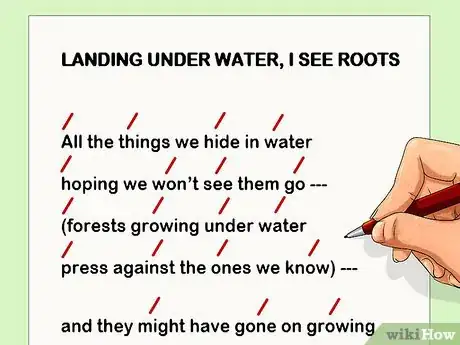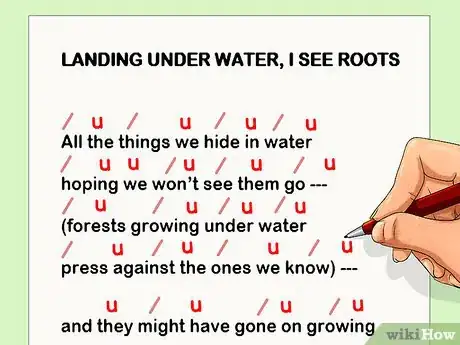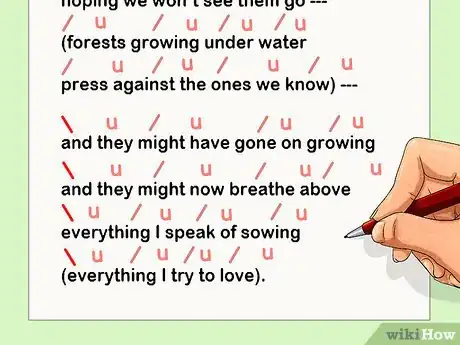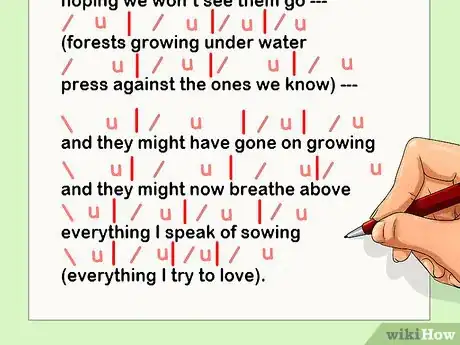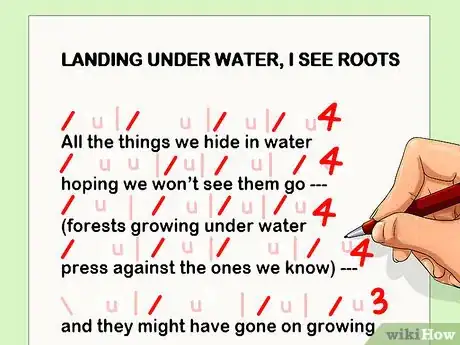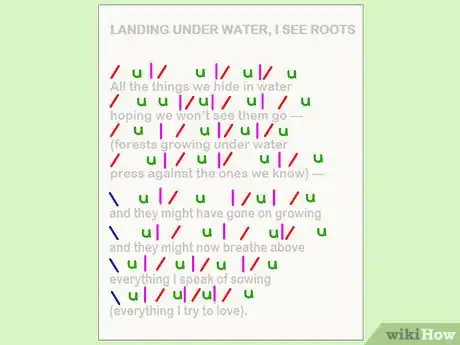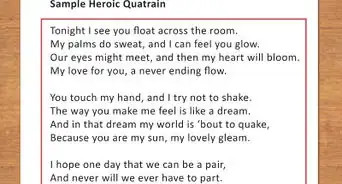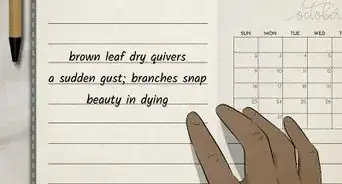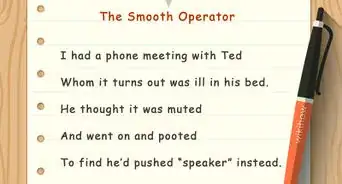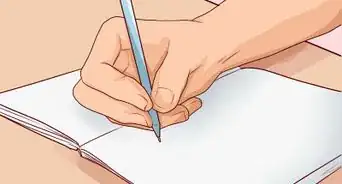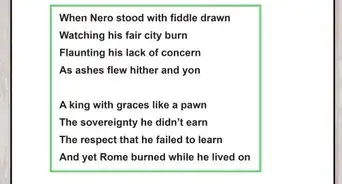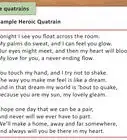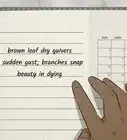This article was co-authored by Stephanie Wong Ken, MFA. Stephanie Wong Ken is a writer based in Canada. Stephanie's writing has appeared in Joyland, Catapult, Pithead Chapel, Cosmonaut's Avenue, and other publications. She holds an MFA in Fiction and Creative Writing from Portland State University.
This article has been viewed 295,002 times.
Scanning a poem, also known as prosody, is the process of marking the stresses in a poem. You will need to note where the sound is stressed when the poem is read aloud. You may need to scan a poem for a class or decide to try it to deepen your reading of a poem. Start by preparing the poem for scanning. Then, scan the poem by marking the stronger and weaker syllables as well as the foot boundary and the meter.
Steps
Preparing the Poem for Scanning
-
1Double space the poem. To scan a poem, you will need to use scanning symbols above each word in the poem. Make sure there is at least one line of space between each line of the poem so you can scan it properly.
- Keep in mind scanning symbols are always placed above each word, never below. This will make it easy for you to keep track of your scan of each line.
-
2Have a physical copy of the poem. You will need to write directly above the words in the poem to do the scan properly. Print out the poem, double spaced, and use a pen or pencil to scan it directly on the page.[1]
- If you are using a poem in a book, you may need to type it up double spaced and print it out or write it down on a piece of paper.
Advertisement -
3Find a quiet space to scan the poem. Scanning a poem requires you to listen to each syllable in every word of the poem out loud. To do this successfully, you will need to be in a space that is very quiet and has no surrounding noise or distractions. Go to a quiet area like a study room or your bedroom.[2]
- You may also tell others around you that you are not to be disturbed while you scan the poem so you can concentrate.
Marking the Stronger and Weaker Syllables
-
1Read the poem out loud line by line. Start by reading each line of the poem aloud to yourself. Listen to each word and how each word flows into another. Pay attention to where the words sound the most stressed and the least stressed. Often, you will open your mouth wider for stressed sounds and make your mouth smaller for less stressed sounds.[3]
- You can also try putting your hand under your chin while you read the poem. Notice when your chin drops into your hand and when it does not touch your hand. Stressed sounds usually cause your chin to drop into your hand.
-
2Mark stronger syllables with a “wand.” A wand symbol looks like this: /. It is used when part of a word or an entire word contains stronger syllables. You should notice that the word or part of the word sounds louder when you read it aloud. Use your ear and listen carefully to find the stronger syllables in each word.[4]
- For example, in the line, “My girlfriend hit me in the head,” you would use a “/” over “girl,” “hit,” and “head.” These are the stronger syllables in the line.
- Keep in mind one word can have a stronger syllable and a weaker syllable. For example, “girlfriend,” has a stronger syllable in “girl” and a weaker syllable in '“friend.”
-
3Identify weaker syllables with a “cup.” A cup symbol looks like this: u. Place “u” over any syllables that are not as loud as others when you say them aloud. They will be the less stressed or weaker syllables in the words of the poem.[5]
- Usually any words that are not marked stronger syllables can be marked weaker syllables.
- For example, in the line, “This sunlight shames November where he grieves,” you would place a “u” over “This,” the “light” in “sunlight,” the “No” and “ber” in “November,” and “he.” These are the weaker syllables in the line.
- Remember that you can have a stronger syllable and a weaker syllable in the same word. For example, “November” has a stronger syllable in “vem” and weaker syllables in “No” and “ber.”
-
4Use a “reversed wand” for syllables that are only partly stressed. The reverse wand symbol looks like this: \. It is used rarely when scanning a poem for syllables that are hard to identify and appear only partly stressed. It is often used when there is a disagreement as to whether a word is stressed or not.[6]
- For example, you may have a hard-to-scan line like, “Full of passionate intensity, grappling and free.” A word like “grappling” may be difficult for you to scan as it has three syllables that may sound only partly stressed.
Marking the Foot Boundary and Meter
-
1Mark each foot with a “foot boundary.” A foot boundary symbol looks like this: |. Do the foot boundaries last. Go through the poem and place a foot boundary at the end of a repeating pattern of the same wands and cups, known as a “foot.” In poetry, a “foot” is a group of syllables that make the same pattern in the poem.[7]
- An easy way to do this is to count the wands, or “u” symbols in a line. For example, the line “This sunlight shames November where he grieves” has five “u” symbols (over “This,” “light,” “No,” “ber,” and “he”). You would place the foot boundary after “he” to note the foot boundary is five feet in the poem.
-
2Count the feet in the poem. Count the wands, or “/” symbols, in each line of the poem to determine the foot. The end of each foot should have a foot boundary. This will tell you the line length of the poem.[8]
- For example, for the line “This sunlight shames November where he grieves,” there are five “/” symbols (over “sun," "shames," "vem," "where," and "grieves"). This means it has five feet per each line, or ten feet for every two lines.
- You can determine the meter based on the feet length in the poem. For example, a poem with a ten foot length is called a pentameter. A poem with a two foot length is called a dimeter.
-
3Note how the foot is accented. Doing this will help you determine the pattern of syllables in the poem. Count all the stronger syllables in each foot of the poem. Notice if there is a pattern where there is a less stressed syllable and then a strongly stressed syllable in the poem.[9]
- For example, a common meter in poetry is iambic pentameter. This means there are five stronger syllables, or wands, per a line and the syllable count is 10/10/10. The pattern is one less stressed syllable, followed by a strongly stressed syllable. Each line has a five syllable length, following a 10 syllable count for every two lines.
Community Q&A
-
QuestionWhich words are required to be stressed and why?
 Community AnswerUsually words aren't required to be stressed, syllables are. It can depend on the way the poet wants to make the poem flow or on the type of poem or meter used.
Community AnswerUsually words aren't required to be stressed, syllables are. It can depend on the way the poet wants to make the poem flow or on the type of poem or meter used. -
QuestionHow can I know which syllables are stressed? Only by reading out loud?
 Community AnswerPretty much. Also, just out of a familiarity with English (and if you don't know how to pronounce a word, you can always look it up). For instance, you know that "poem" is PO-em and not po-EM. Sometimes in older stuff (like Shakespeare) stuff was pronounced a little differently (we pronounce "stressed" like "stress'd," they would've pronounced it like "stress-ed" unless they wrote it with the apostrophe), but generally it's pretty straightforward.
Community AnswerPretty much. Also, just out of a familiarity with English (and if you don't know how to pronounce a word, you can always look it up). For instance, you know that "poem" is PO-em and not po-EM. Sometimes in older stuff (like Shakespeare) stuff was pronounced a little differently (we pronounce "stressed" like "stress'd," they would've pronounced it like "stress-ed" unless they wrote it with the apostrophe), but generally it's pretty straightforward. -
QuestionHow do I name a poem when it has one line in Iambic Tetrameter, and the next line in Iambic Trimeter, then one in Iambic Tetrameter, and so on?
 Community AnswerThat's called common meter, which is the most, well, common meter for hymns and a lot of American poetry. Sometimes also called ballad meter, although the rhyme schemes for the two vary.
Community AnswerThat's called common meter, which is the most, well, common meter for hymns and a lot of American poetry. Sometimes also called ballad meter, although the rhyme schemes for the two vary.
References
- ↑ https://www.poetry4kids.com/news/rhythm-in-poetry-you-can-scan-man/
- ↑ https://anniefinch.com/how-to-scan-a-poem/
- ↑ https://public.wsu.edu/~campbelld/amlit/prostips.htm
- ↑ https://www.poetry4kids.com/news/rhythm-in-poetry-you-can-scan-man/
- ↑ https://studylib.net/doc/8162320/the-snappy-guide-to-scanning-a-poem
- ↑ https://anniefinch.com/how-to-scan-a-poem/
- ↑ https://anniefinch.com/how-to-scan-a-poem/
- ↑ https://anniefinch.com/how-to-scan-a-poem/
- ↑ https://owl.english.purdue.edu/owl/resource/570/02/
About This Article
To scan a poem, read it out loud line by line. Listen to each word, and how the words flow into each other. Mark the syllables that sound louder when you read them with a diagonal line, called a wand, placed just above the letters. When you hear syllables that are not as loud, place a u-shape, called a cup, above the letters. Occasionally, you can use a reversed wand for syllables that are only partly stressed. It’s common for a word with more than one syllable to have both wands and cups. Keep reading to learn tips from our reviewer how to use these accents to determine the meter of the poem!
